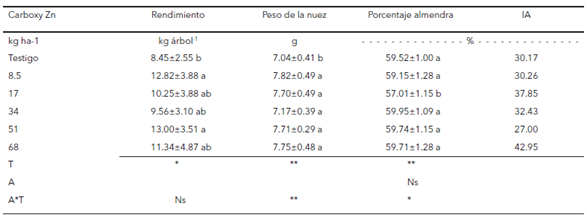Yield, nut quality, alternate bearing in pecan, as a response to soil application of zinc chelates
DOI:
https://doi.org/10.28940/terra.v42i0.1708Keywords:
carya illinoinensis, yield components, agronomic management, kernel percentage, foliar ZnAbstract
Carya illinoinensis (Wangenh.) K. Koch. is a fruit tree with high economic value, however, a crop that is very sensitive to zinc (Zn) deficiency. An alternative is the edaphic application of this micronutrient. The objective of this research was to evaluate the response of physiological variables; yield components and the alternation index to the edaphic application of Zn chelate (g tree-1 of Carboxy Zn) in “Western Schley” pecan tree. During three years in Chihuahua, Mexico, five edaphic doses of Zn chelate (g tree-1 Carboxy Zn) (70, 140, 280, 420, and 560) were evaluated, where T0 corresponds to the control (without application). The experimental design was divided plots with five repetitions. The parameters evaluated were trunk diameter, fruiting shoot length, terminal leaflet area (=AFE, specific leaf area), leaf zinc concentration, yield components (yield, nut size and kernel percentage) and the alternate bearing index. The edaphic application of 420 (g tree-1 of Carboxy Zn) increased physiological parameters such as trunk diameter, shoot length, leaflet area and leaf concentration of Zn, as well as yield components (kilograms tree-1, weight of the nut and kernel percentage) and alternate bearing index. The edaphic application of Carboxy Zn could be an alternative to the supply of Zn in the agronomic management of commercial pecan walnut orchards in alkaline and calcareous soils, a native species with high economic profitability for Mexico
Downloads
Publication Facts
Reviewer profiles N/A
Author statements
- Academic society
- Terra Latinoamericana
- Publisher
- Mexican Society of Soil Science, C.A.

















